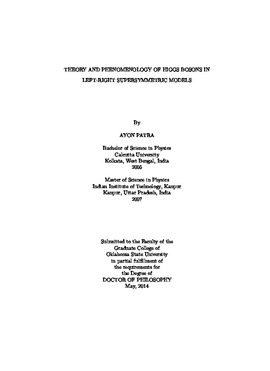| dc.contributor.advisor | Babu, Kaladi S. | |
| dc.contributor.author | Patra, Ayon | |
| dc.date.accessioned | 2015-06-17T20:07:25Z | |
| dc.date.available | 2015-06-17T20:07:25Z | |
| dc.date.issued | 2014-05 | |
| dc.identifier.uri | https://hdl.handle.net/11244/15059 | |
| dc.description.abstract | Scope and Method of Study. In this dissertation, I study the theory and phenomenology of Higgs bosons in the framework of various models with supersymmetry, left-right symmetry and universal extra dimensions. In Chapter 1, I summarize the various models studied and motivation for each. Chapter 2 is devoted to the study of Higgs boson mass spectrum in various left-right supersymmetric models with different symmetry breaking sectors. Chapter 3 involves the collider phenomenology of relatively light doubly-charged Higgs bosons and Higgsinos which arise naturally in supersymmetric left-right models. In Chapter 4, I look at the constraints on a minimal universal extra dimensional model from the measured signal strength for Higgs boson decay at the large hadron collider. | |
| dc.description.abstract | Findings and Conclusions. In Chapter 2, I study Higgs boson mass spectrum in supersymmetric left-right models based on the gauge group SU(3)c x SU(2)L x SU(2)R x U(1)B-L. The constraints on the lightest neutral Higgs boson mass mh is studied in detail. A variety of symmetry breaking scenarios is considered. Several of these models with Higgs triplets and Higgs doublets for SU(2)R symmetry breaking are studied, with additional bidoublets and possibly a gauge singlet. Many of these cases lead to a much higher tree-level neutral Higgs boson mass compared to MSSM. With this enhanced Higgs boson mass, it is possible to accommodate the experimentally observed mass of 126 GeV with a relatively light stops that mix negligibly. In Chapter 3, I look at the collider phenomenology of the doubly-charged Higgs bosons and Higgsinos in the framework of left-right supersymmetric model with automatic R-parity conservation. I analyze a new collider signal resulting from the pair production and decay of a light doubly-charged Higgsino into an even lighter doubly-charged Higgs boson. I investigate the collider signature of these particles with four leptons and missing transverse energy final state at the Large Hadron Collider and show that the discovery reach for both particles can be increased in this channel. In Chapter 4, I investigate the impact of the latest data on Higgs boson branching ratios on the minimal extra dimensional model. The experimental data along with the constraints from the vacuum stability requirements allow for a realistic prediction for the signal strengths in this model. Comparing the calculated results with the observed data, the size parameter R^-1 of the model can be shown to have a lower bound of 1.3 TeV at 95% confidence level. | |
| dc.format | application/pdf | |
| dc.language | en_US | |
| dc.rights | Copyright is held by the author who has granted the Oklahoma State University Library the non-exclusive right to share this material in its institutional repository. Contact Digital Library Services at lib-dls@okstate.edu or 405-744-9161 for the permission policy on the use, reproduction or distribution of this material. | |
| dc.title | Theory and phenomenology of Higgs bosons in left-right supersymmetric models | |
| dc.contributor.committeeMember | Nandi, Satyanarayan | |
| dc.contributor.committeeMember | Agarwal, Girish S. | |
| dc.contributor.committeeMember | Yukihara, Eduardo G. | |
| dc.contributor.committeeMember | Kak, Subhash C. | |
| osu.filename | Patra_okstate_0664D_13309.pdf | |
| osu.accesstype | Open Access | |
| dc.type.genre | Dissertation | |
| dc.type.material | Text | |
| dc.subject.keywords | beyond standard model | |
| dc.subject.keywords | left-right symmetry | |
| dc.subject.keywords | supersymmetry | |
| dc.subject.keywords | universal extra dimension | |
| thesis.degree.discipline | Physics | |
| thesis.degree.grantor | Oklahoma State University | |
